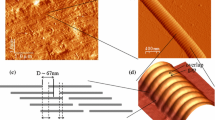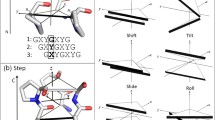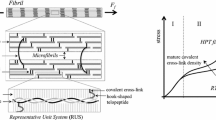Abstract
We report studies of the mechanical properties of tropocollagen molecules under different types of mechanical loading including tension, compression, shear, and bending. Our modeling yields predictions of the fracture strength of single tropocollagen molecules and polypeptides, and also allows for quantification of the interactions between tropocollagen molecules. Atomistic modeling predicts a persistence length of tropocollagen molecules ξ ≈ 23.4 nm, close to experimental measurements. Our studies suggest that to describe large-strain or hyperelastic properties, it is critical to include a correct description of the bond behavior and breaking processes at large bond stretch, information that stems from the quantum chemical details of bonding. We use full atomistic calculations to derive parameters for a mesoscopic bead-spring model of tropocollagen molecules. We demonstrate that the mesoscopic model enables one to study the finite temperature, long-time scale behavior of tropocollagen fibers, illustrating the dynamics of solvated tropocollagen molecules for different molecular lengths.
Similar content being viewed by others
References
R. Langer, D.A. Tirrell: Designing materials for biology and medicine. Nature 428, 487 (2004).
W.A. Petka, J.L. Harden, K.P. McGrath, D. Wirtz, D.A. Tirrell: Reversible hydrogels from self-assembling artificial proteins. Science 281, 389 (1998).
S.A. Maskarinec, D.A. Tirrell: Protein engineering approaches to biomaterials design. Curr. Opin. Biotechnol. 16, 422 (2005).
J.M. Smeenk, M.B.J Otten, J. Thies, D.A. Tirrell, H.G. Stunnenberg, J.C.M. van Hest: Controlled assembly of macromolecular beta-sheet fibrils. Angew. Chem., Int. Ed. 44, 1968 (2005).
M.L. Mock, T. Michon, J.C.M. van Hest, D.A. Tirrell: Stereoselective incorporation of an unsaturated isoleucine analogue into a protein expressed in E. coli. Chembiochem. 7, 83 (2006).
M.R. Diehl, K.C. Zhang, H.J. Lee, D.A. Tirrell: Engineering cooperativity in biomotor-protein assemblies. Science 311, 1468 (2006).
L. Bozec, M. Horton: Topography and mechanical properties of single molecules of type I collagen using atomic force microscopy. Biophys. J. 88, 4223 (2005).
A. Bhattacharjee, M. Bansal: Collagen structure: The Madras triple helix and the current scenario. IUBMB Life 57, 161 (2005).
J.P. Borel, J.C. Monboisse: Collagens—Why such a complicated structure. C. R. Seances Soc. Biol. Fil. 187, 124 (1993).
S.M. Mithieux, A.S. Weiss Elastin: Elastin, in Fibrous Proteins: Coiled-Coils, Collagen and Elastomers. Advances in Protein Chemistry, Vol. 70, edited by D.A.D Parry and J.M. Squire (Elsevier Academic Press, Amsterdam, 2005), p. 437.
B. Li, V. Daggett: Molecular basis for the extensibility of elastin. J. Muscle Res. Cell Motil. 23, 561 (2002).
C. Hellmich, F.J. Ulm: Are mineralized tissues open crystal foams reinforced by crosslinked collagen? Some energy arguments. J. Biomech. 35, 1199 (2002).
R.Z. Kramer, M.G. Venugopal, J. Bella, P. Mayville, B. Brodsky, H.M. Berman: Staggered molecular packing in crystals of a collagen-like peptide with a single charged pair. J. Mol. Biol. 301, 1191 (2000).
M. Zervakis, V. Gkoumplias, M. Tzaphlidou: Analysis of fibrous proteins from electron microscopy images. Med. Eng. Phys. 27, 655 (2005).
B.E. Layton, S.M. Sullivan, J.J. Palermo, G.J. Buzby, R. Gupta, R.E. Stallcup: Nanomanipulation and aggregation limitations of self-assembling structural proteins. Microelectron. J. 36, 644 (2005).
K.N. An, Y.L. Sun, Z.P. Luo: Flexibility of type I collagen and mechanical property of connective tissue. Biorheology 41, 239 (2004).
Y.L. Sun, Z.P. Luo, A. Fertala, K.N. An: Stretching type II collagen with optical tweezers. J. Biomech. 37, 1665 (2004).
Y.L. Sun, Z.P. Luo, A. Fertala, K.N. An: Direct quantification of the flexibility of type I collagen monomer. Biochem. Biophys. Res. Commun. 295, 382 (2002).
P.J. Arnoux, J. Bonnoit, P. Chabrand, M. Jean, M. Pithioux: Numerical damage models using a structural approach: Application in bones and ligaments. Eur. Phys. J. Appl. Phys. 17, 65 (2002).
J.H. Waite, X.X. Qin, K.J. Coyne: The peculiar collagens of mussel byssus. Matrix Biol. 17, 93 (1998).
A.C. Lorenzo, E.R. Caffarena: Elastic properties, Young’s modulus determination and structural stability of the tropocollagen molecule: A computational study by steered molecular dynamics. J. Biomech. 38, 1527 (2005).
A.V. Persikov, J.A.M Ramshaw, A. Kirkpatrick, B. Brodsky: Electrostatic interactions involving lysine make major contributions to collagen triple-helix stability. Biochemistry 44, 1414 (2005).
M. Israelowitz, S.W.H Rizvi, J. Kramer, H.P. von Schroeder: Computational modeling of type I collagen fibers to determine the extracellular matrix structure of connective tissues. Protein Eng. Des. Sel. 18, 329 (2005).
S.D. Mooney, T.E. Klein: Structural models of osteogenesis imperfecta-associated variants in the COL1A1 gene. Mol. Cell. Proteomics 1, 868 (2002).
S.D. Mooney, P.A. Kollman, T.E. Klein: Conformational preferences of substituted prolines in the collagen triple helix. Biopolymers 64, 63 (2002).
S.D. Mooney, C.C. Huang, P.A. Kollman, T.E. Klein: Computed free energy differences between point mutations in a collagen-like peptide. Biopolymers 58, 347 (2001).
J.E. Bischoff, E.M. Arruda, K. Grosh: Finite element modeling of human skin using an isotropic, nonlinear elastic constitutive model. J. Biomech. 33, 645 (2000).
J.W. Freeman, F.H. Silver: Elastic energy storage in unmineralized and mineralized extracellular matrices (ECMs): A comparison between molecular modeling and experimental measurements. J. Theor. Biol. 229, 371 (2004).
M.J. Buehler, F.F. Abraham, H. Gao: Hyperelasticity governs dynamic fracture at a critical length scale. Nature 426, 141 (2003).
M.J. Buehler, H. Gao: Dynamical fracture instabilities due to local hyperelasticity at crack tips. Nature 439, 307 (2006).
A.D. MacKerell, D. Bashford, M. Bellott, R.L. Dunbrack, J.D. Evanseck, M.J. Field, S. Fischer, J. Gao, H. Guo, S. Ha, et al.: All-atom empirical potential for molecular modeling and dynamics studies of proteins. J. Phys. Chem. B 102, 3586 (1998).
J.C. Phillips, R. Braun, W. Wang, J. Gumbart, E. Tajkhorshid, E. Villa, C. Chipot, R.D. Skeel, L. Kale, K. Schulten: Scalable molecular dynamics with NAMD. J. Comput. Chem. 26, 1781 (2005).
M.T. Nelson, W. Humphrey, A. Gursoy, A. Dalke, L.V. Kale, R.D. Skeel, K. Schulten: NAMD: A parallel, object oriented molecular dynamics program. Int. J. Supercomp. Appl. High Perf. Comput. 10, 251 (1996).
D. Anderson: Collagen self-assembly: A complementary experimental and theoretical perspective. University of Toronto, 2005.
D.W. Brenner, O.A. Shenderova, J.A. Harrison, S.J. Stuart, B. Ni, S.B. Sinnott: A second-generation reactive empirical bond order (REBO) potential energy expression for hydrocarbons. J. Phys.: Condens. Matter 14, 783 (2002).
S.J. Stuart, A.B. Tutein, J.A. Harrison: A reactive potential for hydrocarbons with intermolecular interactions. J. Chem. Phys. 112, 6472 (2000).
A.C.T.v. Duin, A. Strachan, S. Stewman, Q. Zhang, X. Xu, W.A. Goddard: ReaxFF SiO: Reactive force field for silicon and silicon oxide systems. J. Phys. Chem. A 107, 3803 (2003).
A.C.T.v. Duin, S. Dasgupta, F. Lorant, W.A. Goddard: ReaxFF: A reactive force field for hydrocarbons. J. Phys. Chem. A 105, 9396 (2001).
M.J. Buehler, A.C.T.v. Duin, W.A. Goddard: Multi-paradigm modeling of dynamical crack propagation in silicon using a reactive force field. Phys. Rev. Lett. 96, 09505 (2006).
A. Strachan, A.C.T. van Duin, D. Chakraborty, S. Dasgupta, W.A. Goddard: Shock waves in high-energy materials: The initial chemical events in nitramine RDX. Phys. Rev. Lett. 91, 098301 (2003).
K.D. Nielson, A.C.T.v. Duin, J. Oxgaard, W. Deng, W.A. Goddard: Development of the ReaxFF reactive force field for describing transition metal catalyzed reactions, with application to the initial stages of the catalytic formation of carbon nanotubes. J. Phys. Chem. A 109, 49 (2005).
S.S. Han, A.C.T. van Duin, W.A. Goddard, H.M. Lee: Optimization and application of lithium parameters for the reactive force field, ReaxFF. J. Phys. Chem. A. 109, 4575 (2005).
K. Chenoweth, S. Cheung, A.C.T. van Duin, W.A. Goddard, E.M. Kober: Simulations on the thermal decomposition of a poly(dimethylsiloxane) polymer using the ReaxFF reactive force field. J. Am. Chem. Soc. 127, 7192 (2005).
A. Strachan, E.M. Kober, A.C.T. van Duin, J. Oxgaard, W.A. Goddard: Thermal decomposition of RDX from reactive molecular dynamics. J. Chem. Phys. 107, 3803 (2005).
S. Cheung, W.Q. Deng, A.C.T. van Duin, W.A. Goddard: ReaxFF(MgH) reactive force field for magnesium hydride systems. J. Phys. Chem. A 109, 851 (2005).
K.D. Nielson, A.C.T. van Duin, J. Oxgaard, W. Deng, W.A. Goddard: Development of the ReaxFF reactive force field for describing transition metal catalyzed reactions, with application to the initial stages of the catalytic formation of carbon nanotubes. J. Phys. Chem. A 109, 493 (2005).
L. Tao, M.J. Buehler, A.C.T.v. Duin, W.A. Goddard: Mixed hybrid Dreiding-ReaxFF calculations for modeling enzymatic reactions in proteins. (2005, unpublished).
D. Datta, A.C.T.V Duin, and W.A. Goddard: Extending ReaxFF to biomacromolecules. (2005, unpublished).
A.K. Rappé, W.A. Goddard: Charge eqilibration for molecular-dynamics simulations. J. Phys. Chem. 95, 3358 (1991).
M.J. Buehler, J. Dodson, P. Meulbroek, A. Duin, and W.A. Goddard: The computational materials design facility (CMDF): A powerful framework for multiparadigm multi-scale simulations, in Combinatorial Methods and Informatics in Materials Science edited by M.J. Fasolka, Q. Wang, R.A. Potyrailo, T. Chikyow, U.S. Schubert, and A. Korkin (Mater. Res. Soc. Symp. Proc.894, Warrendale, PA, 2006), p. 327.
J. Stone, J. Gullingsrud, P. Grayson, and K. Schulten: A system for interactive molecular dynamics simulation, in 2001 ACM Symposium on Interactive 3D Graphics edited by J.F. Hughes and C.H. Sequin (ACM Press, New York, 2001), pp. 191–194.
W. Humphrey, A. Dalke, K. Schulten: VMD: Visual molecular dynamics. J. Mol. Graphics 14, 33 (1996).
M.P. Allen and D.J. Tildesley, Computer Simulation of Liquids (Oxford University Press, New York, 1989).
F. Ercolessi, J.B. Adams: Interatomic potentials from 1st principle-calculations—the force matching method. Europhys. Lett. 28, 583 (1994).
S. Plimpton: Fast parallel algorithms for short-range molecular-dynamics. J. Comput. Phys. 117, 1 (1995).
R.O. Ritchie, J.J. Kruzic, C.L. Muhlstein, R.K. Nalla, E.A. Stach: Characteristic dimensions and the micro-mechanisms of fracture and fatigue in “nano” and “bio” materials. Int. J. Fract. 128, 1 (2004).
R.K. Nalla, J.J. Kruzic, J.H. Kinney, R.O. Ritchie: Mechanistic aspects of fracture and R-curve behavior in human cortical bone. Biomaterials 26, 217 (2005).
R.K. Nalla, J.H. Kinney, R.O. Ritchie: Effect of orientation on the in vitro fracture toughness of dentin: The role of toughening mechanisms. Biomaterials 24, 3955 (2003).
D.A. Pearlman, D.A. Case, J.W. Caldwell, W.S. Ross, T.E. Cheatham, S. Debolt, D. Ferguson, G. Seibel, P. Kollman: AMBER, A package of computer-programs for applying molecular mechanics, normal-mode analysis, molecular-dynamics and free-energy calculations to simulate the structural and energetic properties of molecules. Comput. Phys. Commun. 91, 1 (1995).
Author information
Authors and Affiliations
Corresponding author
Rights and permissions
About this article
Cite this article
Buehler, M.J. Atomistic and continuum modeling of mechanical properties of collagen: Elasticity, fracture, and self-assembly. Journal of Materials Research 21, 1947–1961 (2006). https://doi.org/10.1557/jmr.2006.0236
Received:
Accepted:
Published:
Issue Date:
DOI: https://doi.org/10.1557/jmr.2006.0236




